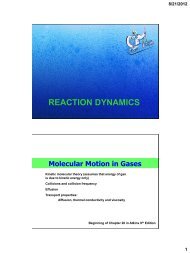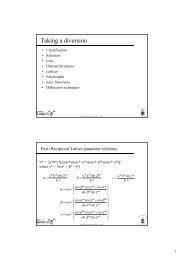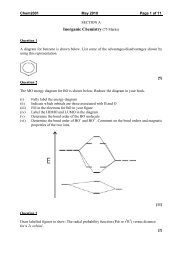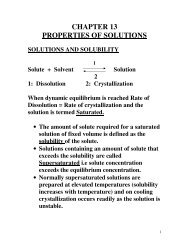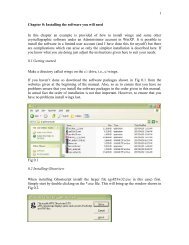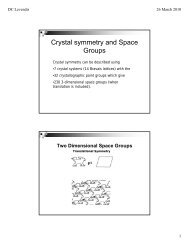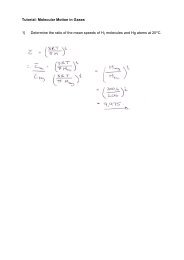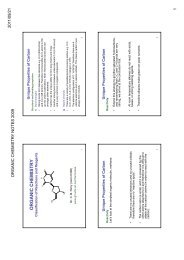ELECTROCHEMISTRY - Wits Structural Chemistry
ELECTROCHEMISTRY - Wits Structural Chemistry
ELECTROCHEMISTRY - Wits Structural Chemistry
Create successful ePaper yourself
Turn your PDF publications into a flip-book with our unique Google optimized e-Paper software.
Measuring the conductivity of tap water:<br />
κ<br />
=<br />
c<br />
Λ<br />
Λ<br />
m = molar conductivity (S cm 2 mol -1 )<br />
m c = molarity<br />
If κ ∝ c, the molar conductivity should be<br />
independent of the concentration of an<br />
electrolyte. Is this the case<br />
Parallel<br />
plates<br />
293.3 µS / cm<br />
1 S = 1 Siemen<br />
= 1 Ω -1<br />
NO!<br />
Molar conductivity varies with<br />
concentration because:<br />
- no. of ions in solution may not be<br />
proportional to concentration (especially<br />
for weak electrolytes)<br />
- ions interact strongly with one another<br />
reducing effective charge<br />
NB: Don’t confuse conductivity (κ) with conductance (G)<br />
Strong electrolyte – Λ m<br />
decreases slightly as<br />
conc increases.<br />
Weak electrolyte –<br />
normal Λ m at low conc,<br />
but Λ m decreases sharply<br />
as conc increases.<br />
1<br />
G =<br />
R<br />
Kohlrausch’s law:<br />
At low concentrations, molar conductivities vary with the square root of conc.<br />
Λ = Λ − K c<br />
m<br />
Λ o m<br />
= ν<br />
o<br />
m<br />
+<br />
λ<br />
+<br />
+ ν<br />
−λ<br />
−<br />
STRONG ELECTROLYTES<br />
Λ m o = limiting molar conductivity<br />
(ions are infinitely far apart no interaction)<br />
K → related to stoichiometry of electrolyte<br />
Kohlrausch’s law of independent migration of ions:<br />
Λ m o → expressed as sum of contributions from its individual ions.<br />
λ = limiting molar conductivity of ions<br />
ν = no. of ions per formula unit of electrolyte<br />
H +<br />
34.96 OH -<br />
19.91<br />
Na + 5.01 Cl -<br />
7.63<br />
K + 7.35 Br -<br />
7.81<br />
Zn 2+ 10.56 SO 2-<br />
4 16.00<br />
e.g. for MgCl 2 : ν + = 1 ν − = 2<br />
Limiting ionic conductivies in water at 298 K, λ /mS m 2 mol -1<br />
Weak electrolytes do NOT dissociate completely,<br />
conductivity of weak electrolytes depends on the degree of ionization (α)<br />
e.g. HA + H 2 O A - + H 3 O +<br />
+ −<br />
[H3O<br />
][A ]<br />
+<br />
K<br />
[ H3O<br />
] = αc<br />
a =<br />
[HA]<br />
−<br />
[ A ] = αc<br />
2<br />
α c<br />
Ka<br />
=<br />
[ HA] = ( 1−<br />
α)c<br />
1 − α<br />
At infinite dilution the electrolyte is fully<br />
ionised :<br />
Λ o m<br />
= ν<br />
+<br />
λ<br />
+<br />
+ ν<br />
−λ<br />
−<br />
At very low conc’s:<br />
Ostwald’s<br />
dilution<br />
law<br />
WEAK ELECTROLYTES<br />
Λ = α<br />
o<br />
m<br />
Λ m<br />
1 1 Λ<br />
mc<br />
= +<br />
o<br />
Λ<br />
m Λ<br />
m K<br />
( Λ ) o 2<br />
1 1 1<br />
= + Λ<br />
mc<br />
o<br />
o 2<br />
Λ<br />
m Λ<br />
m K<br />
a<br />
( Λ<br />
m<br />
)<br />
y c m x<br />
a<br />
m<br />
(c = formal conc of HA)<br />
Example 6<br />
Calculate the degree of ionization and the acid dissociation constant at 298 K for a<br />
0.010 M acetic acid solution that has a resistance of 2220 Ω. The resistance of a 0.100<br />
M potassium chloride solution was also found to be 28.44 Ω.<br />
Λ m (0.1 M KCl) = 129 S cm 2 mol -1<br />
λ o (H + ) = 349.6 S cm 2 mol -1<br />
λ o (CH 3 COO - ) = 40.9 S cm 2 mol -1<br />
Example 7<br />
The molar conductivity of a strong electrolyte in water at 25 °C was found to be 109.9<br />
S cm 2 mol -1 for a concentration of 6.2 × 10 -3 mol L -1 and 106.1 S cm 2 mol -1 for a<br />
concentration of 1.5 × 10 -3 mol L -1 .<br />
Estimate the limiting molar conductivity of the electrolyte.<br />
5



